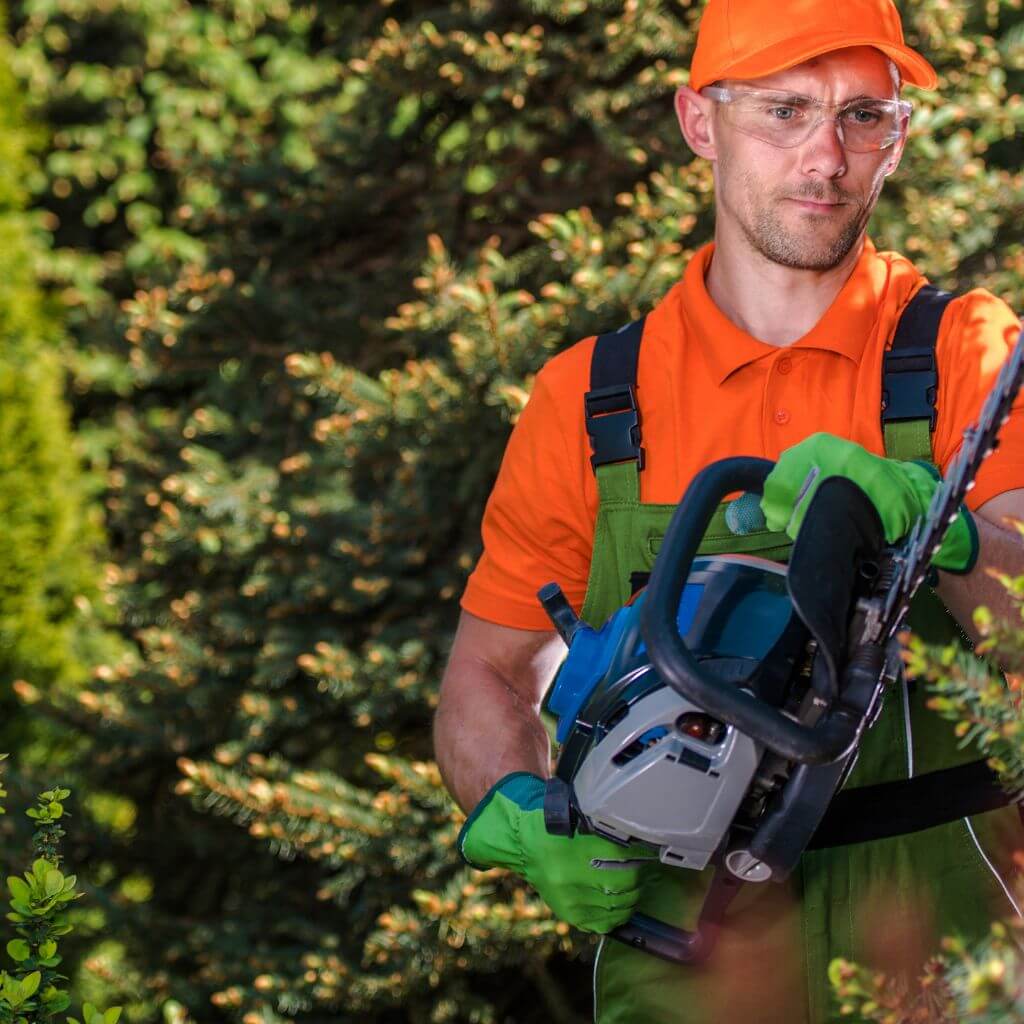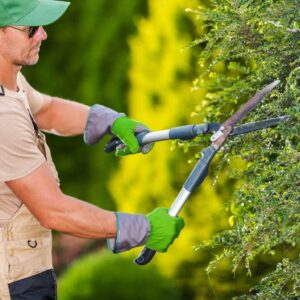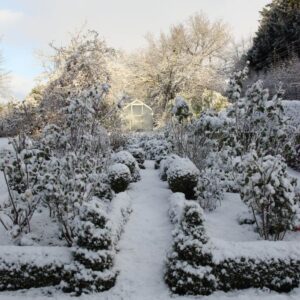
Welcome to “A Beginner’s Guide to Pruning Shrubs and Trees.” In this article, you will learn the basics of pruning to help your plants thrive and stay healthy.
From understanding the different types of pruning cuts to knowing when and how to prune, you will gain the knowledge needed to confidently care for your shrubs and trees. By following these simple tips, you’ll be on your way to maintaining beautiful and well-shaped plants in your garden.
Let’s get started! Have you ever looked at your overgrown shrubs and trees and wondered how to handle them? Well, you’re in luck! In this beginner’s guide, you’ll learn all about the basics of pruning shrubs and trees, including how to safely use a hedge trimmer.
FUnderstanding Pruning Shrubs and Trees
Pruning is essential for maintaining the health and shape of your shrubs and trees. It involves removing dead or diseased branches, shaping the plant for aesthetic purposes, and encouraging new growth. But before you grab your tools and start cutting away, there are a few things you need to know.
When you prune a plant, you’re essentially controlling its growth. By removing certain branches, you can direct where the plant puts its energy, resulting in a healthier and more attractive specimen.
The Purpose of Pruning Shrubs and Trees
Pruning shrubs and tress serves multiple purposes, including:
- Removing dead, damaged, or diseased branches to improve the overall health of the plant.
- Shaping the plant to encourage a more desired growth pattern.
- Promoting new growth by stimulating the plant to produce more branches and leaves.
- Increasing air circulation and sunlight penetration, which can help prevent diseases and promote healthy growth.
Understanding the purpose of pruning will help you approach the task with confidence and ensure that you’re making the right cuts at the right time.
Tools of the Trade
Before you can start pruning, you’ll need to gather the right tools. While the specific tools you’ll need may vary depending on the size and type of shrub or tree you’re working on, there are a few essential items that every beginner pruner should have in their arsenal.
Here are some basic pruning tools you’ll need:
| Tool Name | Description |
|---|---|
| Hand Pruners | Used for cutting small branches and stems up to 1 inch in diameter. |
| Loppers | A larger version of hand pruners, loppers are used for cutting thicker branches up to 2 inches in diameter. |
| Pruning Saw | For cutting branches larger than 2 inches in diameter. |
| Hedge Trimmer | Specifically designed for shaping and trimming hedges and shrubs. |
Having the right tools will make the pruning process much easier and more efficient. Make sure your tools are sharp and well-maintained to ensure clean cuts and reduce the risk of damage to your plants.
The Basics of Using a Hedge Trimmer
If you’re tackling overgrown shrubs or hedges, a hedge trimmer can be a lifesaver. However, using a hedge trimmer requires some know-how to ensure that you’re getting the results you want without causing harm to your plants. Here are some tips for safely using a hedge trimmer:
Safety First
Before you start using a hedge trimmer, make sure you’re wearing the appropriate safety gear, including safety goggles, gloves, and sturdy footwear. Be aware of your surroundings and watch out for obstacles such as rocks, branches, or uneven ground that could trip you up.
Choosing the Right Hedge Trimmer
There are two main types of hedge trimmers: electric and gas-powered. Electric hedge trimmers are more lightweight and eco-friendly, while gas-powered trimmers offer more power and mobility. Choose the type of hedge trimmer that best suits your needs and experience level.
Positioning Yourself
When using a hedge trimmer, stand with your feet shoulder-width apart and keep a firm grip on the tool with both hands. Make sure the trimmer is at the correct angle to the shrub or hedge to ensure a clean and even cut.
Cutting Techniques
Start by trimming the sides of the shrub to create a smooth, straight edge. Work your way from the bottom to the top, using a fluid motion to maintain an even cut. Avoid cutting too deeply into the shrub, as this can damage the plant and hinder its growth.
Maintenance Tips
After using a hedge trimmer, clean the blades with a disinfectant to prevent the spread of diseases between plants. Make sure to oil the blades regularly and store the trimmer in a dry place to prevent rust and corrosion.
By following these tips, you can safely and effectively use a hedge trimmer to shape and prune your shrubs and trees.
Pruning Techniques
Now that you have a good grasp of the basics, let’s dive into some common pruning techniques that you can use to keep your shrubs and trees in top shape.

Thinning
Thinning is a pruning technique that involves removing select branches throughout the canopy to allow more light and air to reach the center of the plant. This helps promote new growth and reduces the risk of disease by improving air circulation. Thinning is especially beneficial for dense shrubs and trees that have become overcrowded with foliage.
Heading
Heading is the practice of cutting back the tips of branches to promote new growth and shape the plant. This technique is often used to maintain the size and form of shrubs and trees, as well as to encourage branching and flowering. When heading, be sure to make cuts at a 45-degree angle just above a bud or lateral branch.
Deadheading
Deadheading is the removal of spent flowers from plants to encourage new blooms and prevent seed development. This technique is commonly used on flowering shrubs such as roses and hydrangeas to prolong the blooming period and keep the plant looking tidy. Deadheading can also prevent self-seeding and conserve the plant’s energy for new growth.
Pollarding
Pollarding is a pruning technique that involves cutting back the main branches of a tree to stimulate new growth. This drastic form of pruning is often used on trees that have outgrown their space or need rejuvenation. Pollarding is typically done in late winter or early spring when the tree is dormant and can withstand heavy pruning.
Rejuvenation
Rejuvenation pruning is a more extreme form of pruning that involves cutting back the entire plant to stimulate new growth. This technique is often used on overgrown or neglected shrubs and trees to restore their health and vigor.
Rejuvenation pruning shrubs and trees should be done in stages over a period of several years to avoid shocking the plant.
By mastering these pruning techniques, you’ll be well equipped to tackle a wide range of pruning tasks and keep your shrubs and trees looking their best year-round.
When to Prune
Knowing when to prune is just as important as knowing how to prune. Different plants have different pruning requirements, so it’s essential to time your pruning activities correctly to promote healthy growth and flowering.
Spring
Spring is an ideal time to prune most shrubs and trees, as it allows for new growth to emerge and heal quickly. Pruning in early spring before new growth appears can help shape the plant and remove any winter damage. Avoid pruning spring-blooming shrubs such as lilacs and forsythia in spring, as you may remove flower buds.

Summer
Summer is best reserved for shaping maintaining and pruning shrubs and trees. Avoid heavy pruning in summer, as it can stress the plant and make it more susceptible to sunburn and disease. Summer is a good time to deadhead flowers and cut back any overgrown branches.
Fall
Fall pruning is generally not recommended, as it can stimulate new growth that may not have time to harden off before winter. However, you can do some light pruning in fall to remove dead or diseased branches and shape the plant before dormancy. Avoid pruning frost-sensitive plants in fall, as it can make them more vulnerable to cold damage.
Winter
Winter is an excellent time to do heavy pruning on deciduous trees and shrubs when they are dormant. Avoid pruning evergreen plants in winter, as they may not recover well from the stress. Winter pruning is also a good time to prune fruit trees to shape them and remove any dead or crossing branches.
By pruning at the right time of year, you can help your plants thrive and ensure that they look their best throughout the seasons.

Common Pruning Mistakes to Avoid
Pruning can be a rewarding task, but it’s essential to do it correctly to avoid damaging your plants. Here are some common pruning mistakes to watch out for and tips on how to avoid them:
1. Incorrect Pruning Cuts
Making improper cuts, such as cutting too close to the trunk or leaving stubs, can damage the plant and hinder its growth. To prevent this, always make clean cuts at a 45-degree angle just above a bud or lateral branch. Avoid tearing or crushing the bark, as this can lead to disease and decay.
2. Overpruning
Pruning too much at once can shock the plant and weaken its health. To avoid overpruning, start by removing dead or diseased branches, then step back and assess the plant’s form before making additional cuts. Limit your pruning to no more than one-third of the plant’s total foliage at a time.
3. Pruning Shrubs and Trees at the Wrong Time
Pruning at the wrong time of year can disrupt the plant’s growth cycle and reduce its ability to flower or fruit. Always research the specific pruning requirements of your plants and time your pruning activities accordingly. Follow the general guidelines of pruning in late winter or early spring for deciduous plants and after flowering for spring-blooming shrubs.
4. Neglecting Maintenance
Failing to maintain your pruning tools for pruning shrubs and trees can lead to dull blades and ragged cuts that damage the plant. Clean and sharpen your tools regularly to ensure clean cuts and reduce the risk of disease transmission. Store your tools in a dry place to prevent rust and corrosion, and replace any damaged or worn-out parts as needed.
5. Ignoring Plant Health
Pruning shrubs and trees that are stressed, diseased, or in poor health can further weaken them and make them more vulnerable to pests and disease. Before pruning, assess the plant’s overall health and address any underlying issues, such as nutrient deficiencies or water stress. Pruning should complement the plant’s natural growth cycle and help improve its vitality, not harm it.
By avoiding these common pruning mistakes, you can ensure that your plants remain healthy, vigorous, and beautiful year after year.
Conclusion Pruning Shrubs and Trees
Pruning shrubs and trees may seem like a daunting task, but with the right knowledge and tools, you can tackle it with confidence.
By understanding the basics of pruning, using the correct techniques, and timing your pruning shrubs and trees appropriately, you can keep your plants healthy and thriving throughout the seasons.
Remember to always prioritize safety, pay attention to your plants’ needs, and take your time to ensure that each cut is made with care. With practice and patience, you’ll soon become a pruning pro, transforming your overgrown shrubs and trees into stunning works of art.
If you enjoyed Pruning Shrubs and Tress Read How to Choose the Best Hedge Trimmer for your Garden 2024
Gardeners World gives some great advice on Pruning Shrubs and Trees and Seven Mistakes to avoid when Pruning Shrubs and Trees





